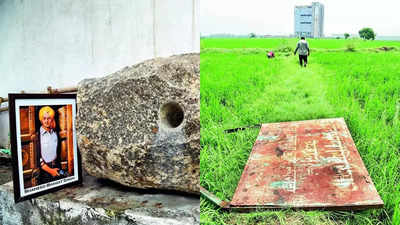Locals, descendants of those revolutionaries, express disappointment over the neglect and lack of memorials. NOIDA: Nalgarha resents the anonymity it finds itself in. The Hindon on one side and Yamuna on the other, it was inconspicuousness that had, however, proved an asset for a group of storied patriots who chanced upon its dense woods and swamps a hundred years ago while they organised against the British.
To locals, many of whom call themselves descendants of freedom fighters who fought alongside Bhagat Singh and answered the call of Netaji's Indian National Army , it is history that fills them with pride, but also chagrin at the lack of recognition. Today's Nalgarha is ringed by luxurious highrises and bordering it is the high-speed Yamuna Expressway. Subsumed by Sector 145 in Noida, it is a far cry from the sanctuary its terrain had provided to Bhagat Singh, who was here in 1927, along with freedom fighters Phool Singh, Karnail Singh and others.

Locals are unhappy over what they describe as " neglect " of their heroes and the lack of a memorial to mark the village's deep connection with the independence movement. People settled down here in 1955, most of them Sikhs and Gujjars, clearing out forests for a settlement of 300 families. Amarjeet Singh's is one of them.
"Karnail Singh lived here all his life. If one had the opportunity to meet him, even in his eighties, one would be astounded by his physical prowess. His towering stature and strong build made him stand out among his peers," Amarjeet (64), a farmer, said.
Amarjeet remembers how Karnail Singh used to bicycle all the way to Dadri to get newspapers after Independence. "We would ask him why he went so far to get papers. Karnail Singh would just reply, 'Dekhun toh desh kitna badal raha hai (I want to see how the country is changing)'," Amarjeet said.
Nalgarha resident Surendra Arya said he is the grandson of Phool Singh and heard stories on how the INA member sought refuge to evade arrest after some revolutionaries assassinated a British officer. "My grandfather and others used this location as a base to strategise and plan other attacks on the British," Surendra said. One of the symbols, according to locals, is a large stone now preserved carefully in the local gurdwara.
They believe it was used to mix explosive chemicals for crude bombs, including that for the Central Legislative Assembly bombing carried out by Bhagat Singh and others in the Delhi of 1929. Two depressions on this rock, visible even today, are results of chemicals being mixed, locals say. But in a village echoing with tales of patriotism, there were no houses waving the Indian flag, a day before the country marks its 78th Independence Day.
"Today, we are able to celebrate this Independence Day because of our ancestors. If our country can't even recognise their role and give the respect that this village actually deserves, then why should we celebrate it?" asked Joginder Singh, a granthi at the gurdwara. Another resident, Tejpal Singh, said Aug 15 "would be just another day for us".
Subhash Bhati, another local resident, said stories of freedom fighters going without food for days while hiding in the area -- handed down through generations -- need to be not just properly told, but also chronicled and recognised. "Sadly, many will not get to know about it," he added. In history records too, there is little mention of Nalgarha and its role in the freedom struggle.
Historian Irfan Habib said he hadn't heard the name of the village. "But there were many secret locations that Bhagat Singh and his associates used as hideouts. There are some spots in Old Delhi too, but it's very difficult to recognise any of them now," he said.
Another historian Aparna Vaidik said Noida wasn't then on the map as it is now. "Maybe, the exact location was never specified then..
. It's interesting how the revolutionaries reside in public memory, almost as if they continue to have several afterlives," she said..



















